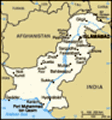Pakistani Economy, Pakistan Economy
Advertisement
Economy - overview: Pakistan, an impoverished and underdeveloped country, has suffered from decades of internal political disputes, low levels of foreign investment, and a costly, ongoing confrontation with neighboring India. However, IMF-approved government policies, bolstered by generous foreign assistance and renewed access to global markets since 2001, have generated solid macroeconomic recovery the last three years. The government has made substantial macroeconomic reforms since 2000, although progress on more politically sensitive reforms has slowed. For example, in the third and final year of its $1.3 billion IMF Poverty Reduction and Growth Facility, Islamabad has continued to require waivers for energy sector reforms. While long-term prospects remain uncertain, given Pakistan's low level of development, medium-term prospects for job creation and poverty reduction are the best in nearly a decade. Islamabad has raised development spending from about 2% of GDP in the 1990s to 4% in 2003, a necessary step towards reversing the broad underdevelopment of its social sector. GDP growth, spurred by double-digit gains in industrial production over the past year, has become less dependent on agriculture. Foreign exchange reserves continued to reach new levels in 2004, supported by robust export growth and steady worker remittances.
GDP: 4.9% (2004)
GDP - real growth rate: 6.1% (2004 est.)
GDP - per capita: Purchasing power parity - $2,200 (2004 est.)
GDP - composition by sector: Agriculture: 22.6% industry: 24.1% services: 53.3% (2004 est.)
Population below poverty line: 32% (FY00/01 est.)
Household income or consumption by percentage share: Lowest 10%: 4.1% highest 10%: 27.6% (FY96/97)
Distribution of family income - Gini index: 41 (FY98/99)
Inflation rate (consumer prices):
Labor force: 45.43 million note: extensive export of labor, mostly to the Middle East, and use of child labor (2004 est.)
Labor force - by occupation: Agriculture 42%, industry 20%, services 38% (2004 est.)
Unemployment rate: 8.3% plus substantial underemployment (2004 est.)
Budget: Revenues: $13.45 billion expenditures: $16.51 billion, including capital expenditures of NA (2004 est.)
Industries: Textiles and apparel, food processing, pharmaceuticals, construction materials, paper products, fertilizer, shrimp
Industrial production growth rate: 13.1% (2004 est.)
Electricity - production: 75.27 billion kWh (2003)
Electricity - production by source:
Electricity - consumption: 52.66 billion kWh (2003)
Electricity - exports: 0 kWh (2003)
Electricity - imports: 0 kWh (2003)
Oil - production: 61,000 bbl/day (2004 est.)
Oil - consumption: 365,000 bbl/day (2004 est.)
Oil - exports: NA
Oil - imports: NA
Oil - proved reserves: 325.5 million bbl (2004 est.)
Natural gas - production: 23.4 billion cu m (2001 est.)
Natural gas - consumption: 23.4 billion cu m (2001 est.)
Natural gas - exports: 0 cu m (2001 est.)
Natural gas - imports: 0 cu m (2001 est.)
Natural gas - proved reserves: 695.6 billion cu m (2004)
Agriculture - products: Cotton, wheat, rice, sugarcane, fruits, vegetables; milk, beef, mutton, eggs
Exports: $15.07 billion f.o.b. (2004 est.)
Exports - commodities: Textiles (garments, bed linen, cotton cloth, and yarn), rice, leather goods, sports goods, chemicals, manufactures, carpets and rugs
Exports - partners: US 23.5%, UAE 7.4%, UK 7.3%, Germany 5%, Hong Kong 4.4% (2004)
Imports: $14.01 billion f.o.b. (2004 est.)
Imports - commodities: Petroleum, petroleum products, machinery, plastics, transportation equipment, edible oils, paper and paperboard, iron and steel, tea
Imports - partners: Saudi Arabia 11.6%, UAE 10%, US 9.7%, China 8.4%, Japan 6.5%, Kuwait 5.6% (2004)
Debt - external: $33.97 billion (2004 est.)
Economic aid - recipient: $2.4 billion (FY01/02)
Currency:
Currency code:
Exchange rates: Pakistani rupees per US dollar - 58.258 (2004), 57.752 (2003), 59.724 (2002), 61.927 (2001), 53.648 (2000)
Fiscal year: 1 July - 30 June
Advertisement
The information here has been derived from Public Domain Sources such as the CIA World Factbook. No liability can be taken for any inaccuracies.
Tot: 0.041s; Tpl: 0.008s; cc: 6; qc: 6; dbt: 0.01s; 1; m:domysql w:travelblog (10.17.0.13); sld: 1;
; mem: 1.1mb

 The separation in 1947 of British India into the Muslim state of Pakistan (with two sections West and East) and largely Hindu India was never satisfactorily resolved, and India and Pakistan have fought two wars - in 1947-48 and 1965 - over the disput...
The separation in 1947 of British India into the Muslim state of Pakistan (with two sections West and East) and largely Hindu India was never satisfactorily resolved, and India and Pakistan have fought two wars - in 1947-48 and 1965 - over the disput...
